Human resource managers and internal comms pros already know the value of employee engagement. But being able to measure employee engagement ROI is critical if you want to prove the value to your organization.
As an internal comms pro, you may have come across the perfect internal communications tool or internal communications software for measuring employee engagement.
You were giddy with excitement. But when you excitedly tell the C-Suite about this great new tool, they don’t quite share your enthusiasm. Instead, they ask you the dreaded question: “That’s all well and good. But what is the ROI on employee engagement?”
Don’t sweat it, we’ve got your back. In this guide, we’ll show you how to measure employee engagement ROI and persuade business leaders to invest in employee engagement.
Take a self-guided tour of ContactMonkey
See how our key features can streamline your internal communications.
Take product tour

Defining Employee Engagement
Employee engagement can be defined as the emotional and intellectual commitment of an employee to their organization and its goals.
It’s the level of involvement and enthusiasm an employee has for their work, and it’s often used as a measure of the overall health and well-being of an organization.
High levels of employee engagement are associated with increased productivity, lower turnover, and improved customer satisfaction.
Why is Employee Engagement Important for Your Business?
If you’re still wondering ‘why is employee engagement important?’, the answer is really quite simple. Engaged employees are happier and more productive at work.
For instance, a Customer Service Representative at your company is more likely to go out of his way to help customers if he’s engaged with his work and loves his job. The more he’s able to help a potential customer, the more likely the customer will end up making a purchase.
In turn, this results in higher sales and more business revenue.
So, employees and employee engagement have a significant impact on your organization’s bottom line. In other words:
Engaged employees = Higher ROI
And if you’re able to make your engaged employees into employee advocates, that’s even better for your company’s ROI.
How to Measure Employee Engagement ROI
We’ve established why employee engagement is important for your organization and how it impacts the company’s bottom line. But what to do next?
It’s time to connect the power of your employees to the necessary support from directors and managers.
To make a sure-fire case for investing in employee engagement, we’ve outlined the best ways to demonstrate employee engagement ROI.
Create and send employee surveys for feedback
Engage staff with pulse surveys, eNPS surveys, reusable surveys, custom polls, and more. Ready to send modern emails?
Explore survey features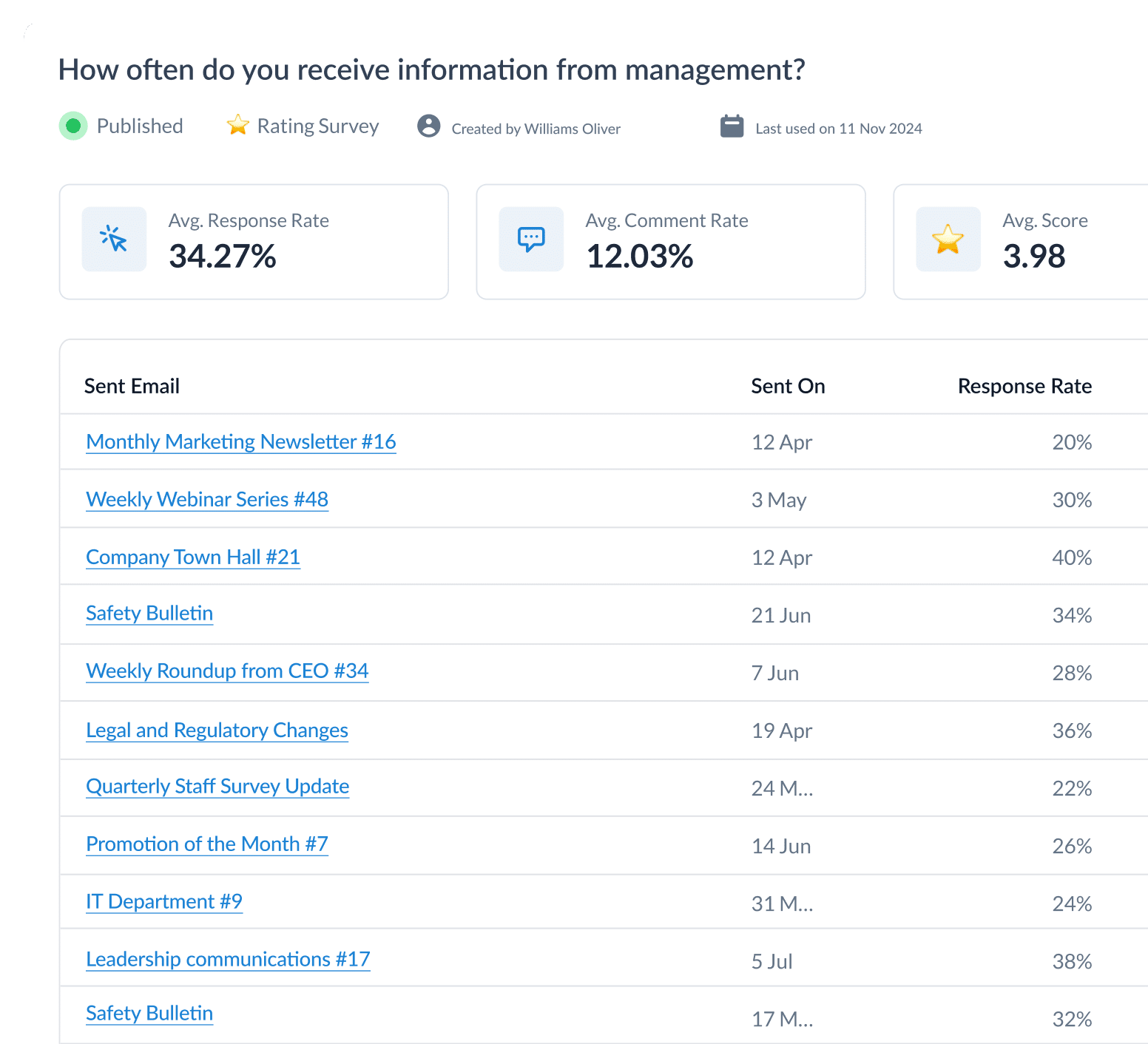
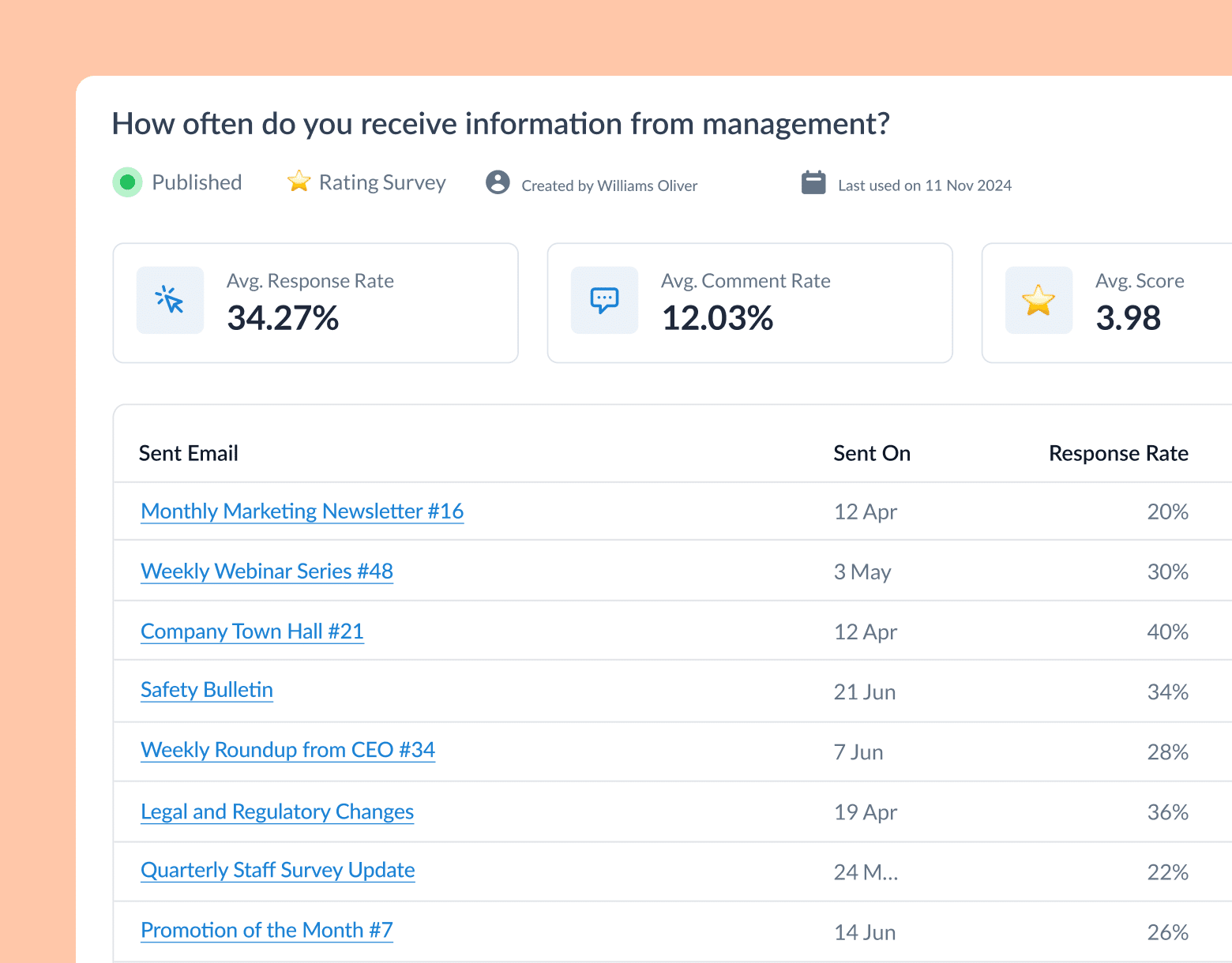
1. Benchmarking surveys
A benchmarking survey is the initial survey you send to your workforce and which you use to set goals for upcoming survey results.
Benchmarking surveys can then be used to compare an organization’s performance to that of other similar companies.
These surveys typically focus on specific areas of performance, such as employee engagement, customer satisfaction, or financial performance, and are used to identify areas where an organization is performing well and areas where improvement is needed.
The results of benchmarking surveys can be used by organizations to set goals and develop strategies for improvement.
They can also be used to track progress over time and to compare performance across different departments or locations. Benchmarking surveys are also used to compare the performance of the company with the industry standards.
Not sure what questions to include in your surveys? Try using ContactMonkey’s OpenAI ChatGPT integration to generate survey questions based on prompts. Simply describe what you’d like to learn, generate the questions, and then edit them according to your audience.
2. Pulse surveys
The best way to start examining the ROI on employee engagement is by getting direct staff feedback. Benchmarking surveys can help.
Using employee engagement surveys is a simple and straightforward employee engagement best practice. But to get in-depth feedback, you’ll need to offer a variety of feedback options that are in-tune with your employees’ communication style.
Remember, the more data you gather, the more you’ll be able to demonstrate to the C-Suite why they should invest in any kind of employee engagement software.
You can also leverage this data to create more engaging internal communications, improve your employee recognition ideas, and reduce employee turnover.
With ContactMonkey’s internal communications tool, you can embed employee pulse surveys right into your internal emails. Choose from a variety of feedback options including star ratings, dichotomous scales, thumbs up/down, and emoji reactions.
Ask questions such as:
- Does your company’s mission/vison inspire you? (yes/no)
- Do you find your work to be meaningful?
- How do you feel when you come into work every day?
Once you have your pick, simply drag and drop your survey into your employee emails using ContactMonkey’s email template builder.
For more in-depth responses and testimonies that you can present in your meetings with senior leadership, offer anonymous comment options.
ContactMonkey’s email template builder offers an easy commenting feature to collect anonymous feedback. This allows employees to expand on any survey response with candid comments.
Once the responses start coming in, track staff feedback in your Campaign Dashboard. You’ll see your email analytics and survey responses in a clear visual display.
You’ll also be able to easily import data into PowerPoint and prepare to show it to your team in a compelling way.
Watch ContactMonkey LIVE in action
Join live demo
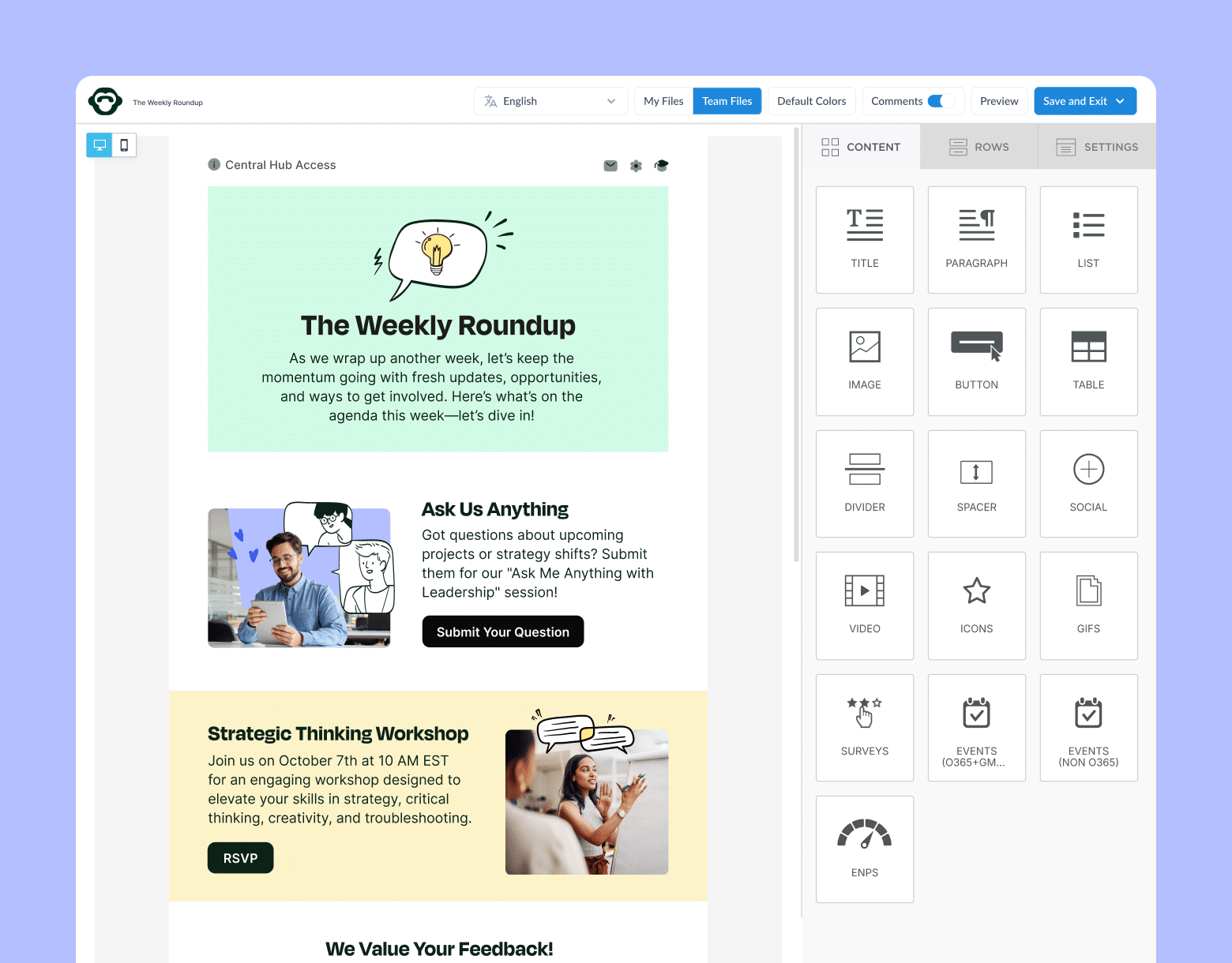
3. One-on-one conversations
One-on-one feedback, also known as individual feedback, is a process in which a manager or supervisor provides direct and specific feedback to an employee about their performance.
There are tons of benefits to using one-on-one feedback as a method of performance evaluation and management. These include:
- Improved communication: One-on-one feedback allows for open and direct communication between an employee and their manager, which can help to improve overall communication within the organization.
- Increased accountability: When employees receive individual feedback, they are more likely to take responsibility for their actions and be held accountable for their performance.
- Tailored feedback: One-on-one feedback allows managers to provide feedback that is tailored to an individual employee’s specific strengths and weaknesses, rather than providing general feedback to a group.
- Enhanced employee motivation: Employees who receive regular, positive feedback are more likely to be motivated to improve their performance.
- Improved performance: One-on-one feedback can help employees to identify areas where they need to improve, and to develop specific plans for improvement.
- Stronger relationships: One-on-one feedback can help to build stronger relationships between employees and managers, as it allows for open, direct communication and mutual understanding.
4. Analyzing existing data
Why should email be your primary mode of measuring employee engagement ROI?
Well, for starters, it’s one of the most preferred mediums for receiving communications among employees.
Email continues as the most commonly used internal communications channel, with 70% of internal communicators relying more on email during the pandemic. Email is a continually strong driver of employee engagement.
With an email tracking tool like ContactMonkey you can see if employees are engaging with important company news, registering to events, and clicking on industry resources.
The amount of time employees spend reading company news and updates is a good indicator of their engagement level. It also means they’re better equipped to promote the company to customers.
Employees who are aware and engaged at work are better at conveying trust in the brand to their clients. That’s because they themselves share in it. And this in turn contributes to employee engagement ROI.
Here are some email engagement metrics that ContactMonkey can help you track:
Opens: let you know whether staff are informed about important company announcements and industry insights. Open rate measures the percentage of employees that open a given email. Use ContactMonkey to find your business’s best send times for internal emails to maximize engagement.
Click-through rate (CTR): a high CTR tells you that the content you’re sending out is relevant and/or entertaining to your audience and the biggest sign that your employee engagement is at a healthy level.
Read time: see how much time employees are spending with your communications and which content captivates them the most.
Location: see if there’s a connection between higher customer satisfaction or employee productivity in a company location where employees engage with your emails the most.
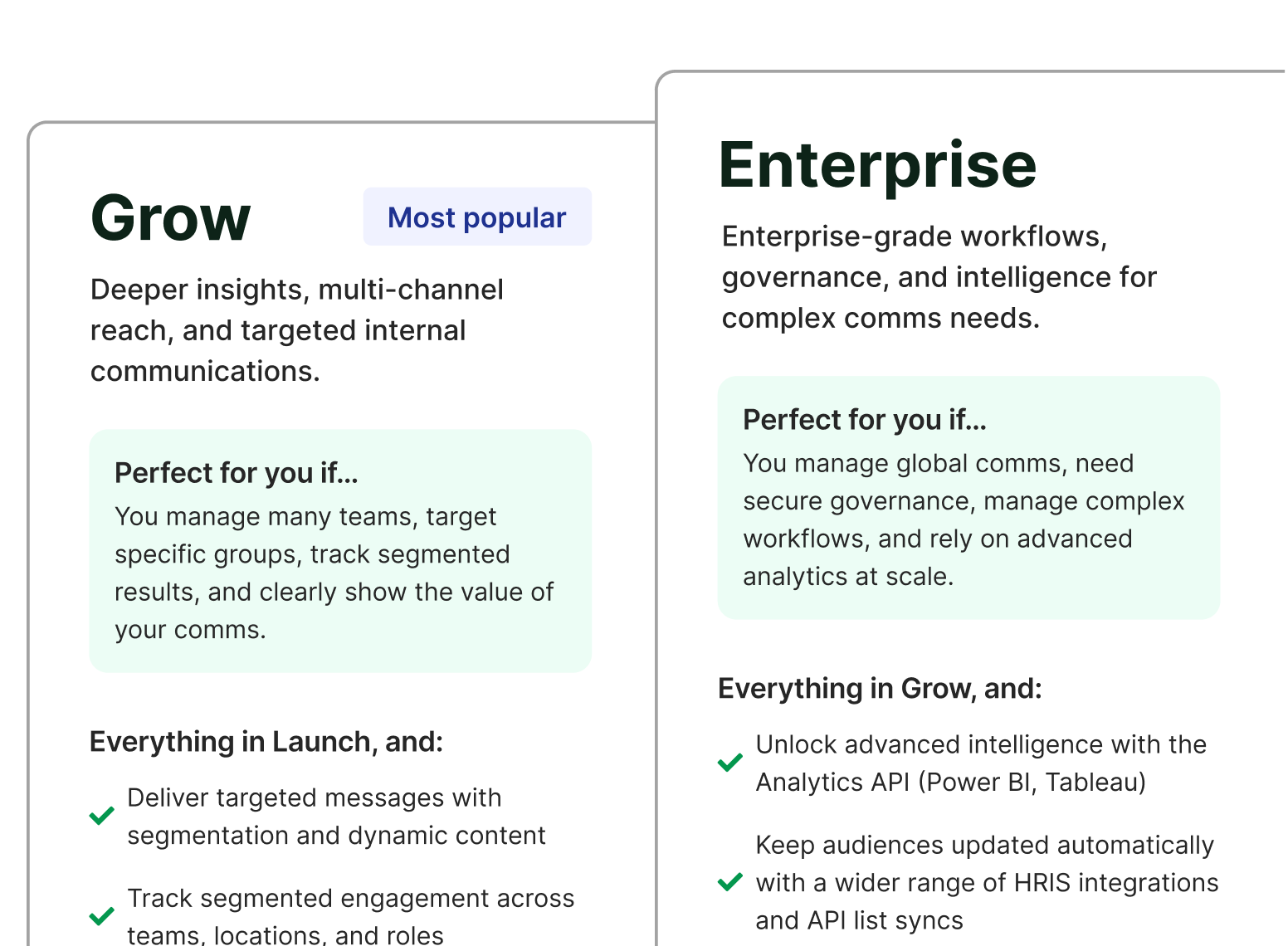
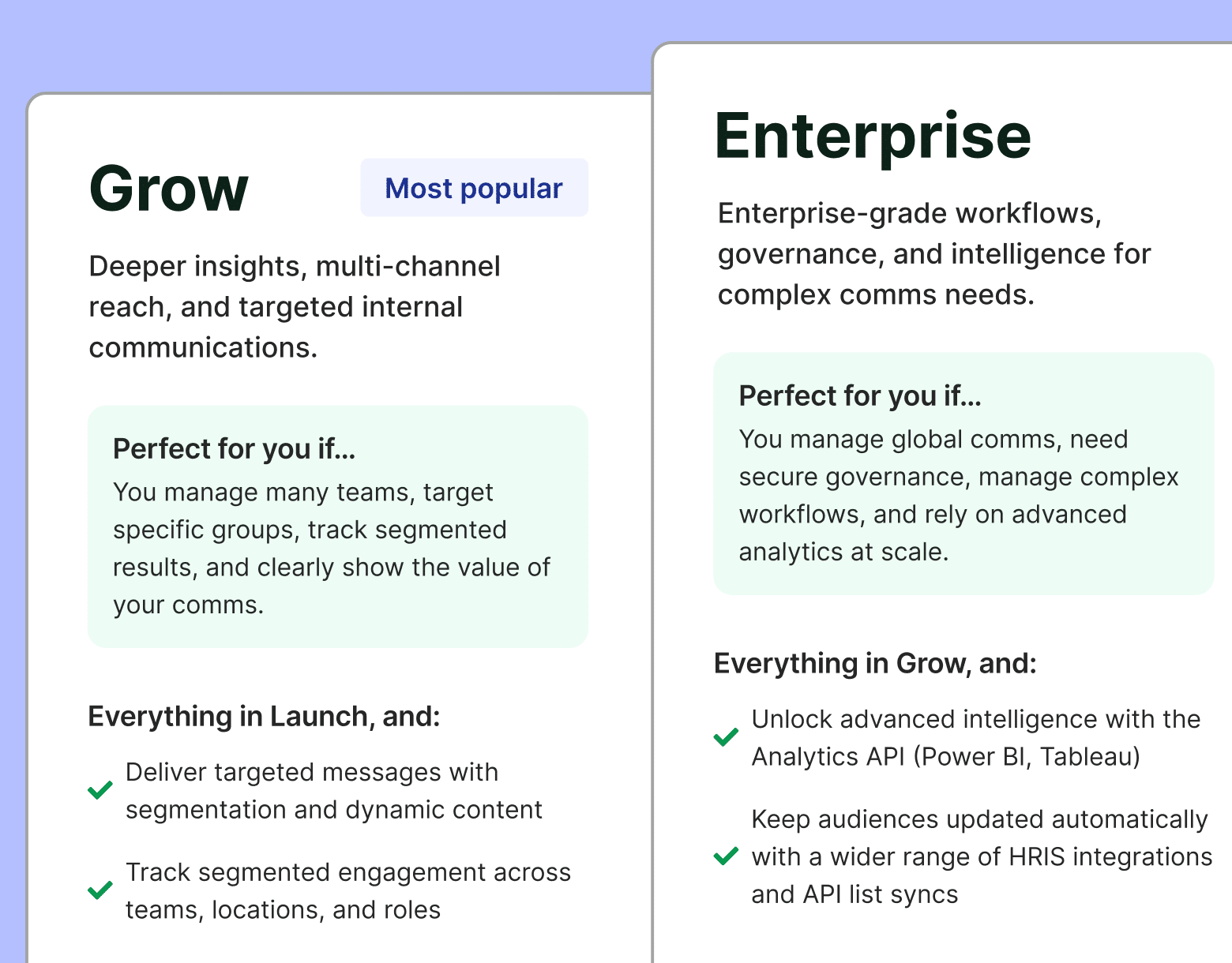
By tracking which content resonates the best in any given branch or location, you can segment your emails and tailor them for increased engagement. Combine these metrics with data from ContactMonkey’s click maps feature, which shows you how your employees are engaging with your emails:
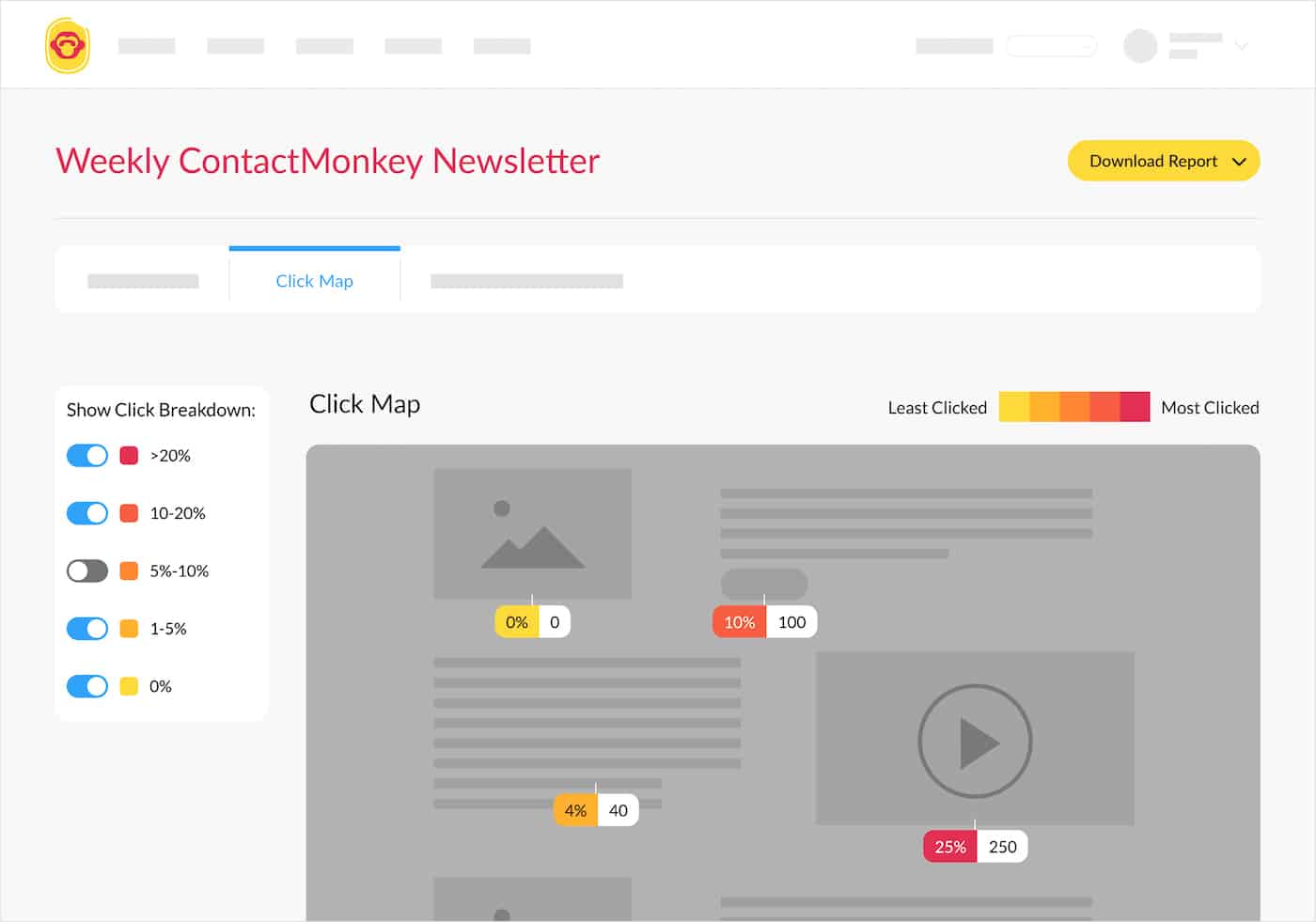
Use click maps to optimize your email design to ensure your employees are seeing the information you need them to.
Increase email engagement on your surveys by targeting only relevant groups of employees. With ContactMonkey’s List Management feature, you can create custom email lists without needing help from IT. Your custom email lists integrate with your Human Resource Information System (HRIS) like Workday and ADP, as well as Azure Active Directory, so they will update automatically.
5. Exit Surveys
An employee exit survey is a survey that is given to employees when they leave an organization. The purpose of an employee exit survey is to gather information from departing employees about their experiences while working at the organization.
This information can then be used to identify areas where the organization can improve in terms of employee satisfaction, retention, and overall performance.
Exit surveys typically cover a wide range of topics, including the employee’s overall job satisfaction, reasons for leaving, perceptions of management, and their experience with their colleagues, benefits, compensation and more.
The survey may also ask about the employee’s future plans and whether they would recommend the organization as a good place to work.
The information obtained through employee exit surveys can be used to identify patterns and trends in employee turnover, and to develop strategies for improving employee retention.
6. Employee Net Promoter Score (eNPS)
What is eNPS? You’ve probably heard of “Net Promoter Score” as a way of measuring the number of customers who would recommend your brand to others.
When it comes to Employee Net Promoter Score, things work similarly. But instead of measuring customer loyalty, eNPS measures your employees’ commitment and engagement.
The goal is to see how many of your employees would recommend your company to others. The medium: a single focused question such as, “How likely is it that you would recommend working at our company to a friend or colleague?”
Employees respond on a scale of 1-10. Based on their responses, they’re divided into three categories: detractors, passives and promoters.
This metric does a good job of showing how your employees truly feel about the company. In turn, it becomes a good indicator of how they’re promoting it to others, which will have big impacts on your business outcomes.
When it’s time to show the ROI on employee engagement to your management team, make sure you include your company’s eNPS score to support the need for bolstering engagement.
With ContactMonkey, you can easily calculate your eNPS score right from your employee newsletter. Simply choose, drag, and drop, the eNPS feature in your email template builder. Then,track and export them from your Campaign Dashboard for detailed analytics.
Start two-way conversations and employee feedback loops
Learn how to engage staff with pulse surveys, content ratings and reactions, custom polls, and more. Ready to send modern emails?
See engagement features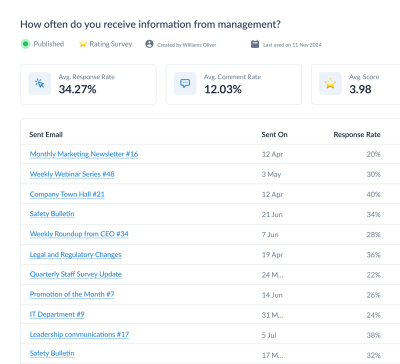

Ways to Calculate Your ROI on Employee Engagement
There are several ways to calculate the ROI on employee engagement in your organization. Below, we’ve listed some of the easiest and most reliable ways:
1. Check employee productivity
Productivity means meeting a certain objective within a specified timeframe. In the modern workplace however, productivity also takes into account the quality of production and the value that employees get from their work.
Employee engagement is directly tied to how much value employees see in their roles. So when the quantity or quality of an employee’s work diminishes, it’s a good sign of disengagement.
In fact, businesses with high employee engagement, have proven to be more profitable than those with low employee engagement.
Ask yourself: have you properly assessed your staff quotas, made sure that they’re attainable, but productivity remains low? Then you need to improve employee engagement.
Collect employee feedback and connect your employee feedback to managers, eNPS, and email analytics with your productivity levels for a specific time period.
If there’s a clear correlation between these elements, you have a good case for investing more in employee engagement. More importantly, you have the data to persuade management to share in your vision and help deliver the resources to do so.
2. Revenue per employee
Revenue per employee is a financial metric used to measure the ROI on employee engagement alongside employee productivity and efficiency. It is calculated by dividing the total revenue of a company by the number of employees. The formula for revenue per employee is:
Revenue per employee = Total Revenue / Number of Employees
For example, if a company has total revenue of $10 million and employs 100 people, the revenue per employee would be $100,000.
Revenue per employee is a useful metric for comparing the productivity of different companies or different departments within a company.
It can also be used to identify areas where a company can improve its efficiency and productivity, such as by increasing revenue or reducing the number of employees.
It is important to note that revenue per employee is a relative metric and should be used in context.
It should be compared with the industry average, with company’s history and with internal goals. Also, it is good to use it in combination with other metrics to get a complete picture of the company’s performance.
3. Employee turnover and retention
Employee turnover happens when staff leaves the company by their own choosing. Engaged and satisfied employees are proven to stay with their companies longer, so if you see staff leaving in large numbers, there’s an issue.
Studies show that employers with high employee engagement scores (20th percentile) experience up to 59% less staff turnover.
That places workplace turnover as one of the biggest indicators of employee disengagement.
Employee engagement and retention, on the other hand, becomes one of the key components of employee engagement ROI.
By presenting the employee turnover rate in relation to employee engagement at your company, you’ll be able to compellingly demonstrate the value of investing in employee engagement to organizational leaders.
To calculate your employee turnover, divide the number of employees who leftthe company in a specified period (say Q1) by the average number of employees in a given period. Multiply the number you get by 100 to get your percentage point.
How much is low employee engagement costing you?
Tally it up with ContactMonkey’s ROI calculator.
Calculate now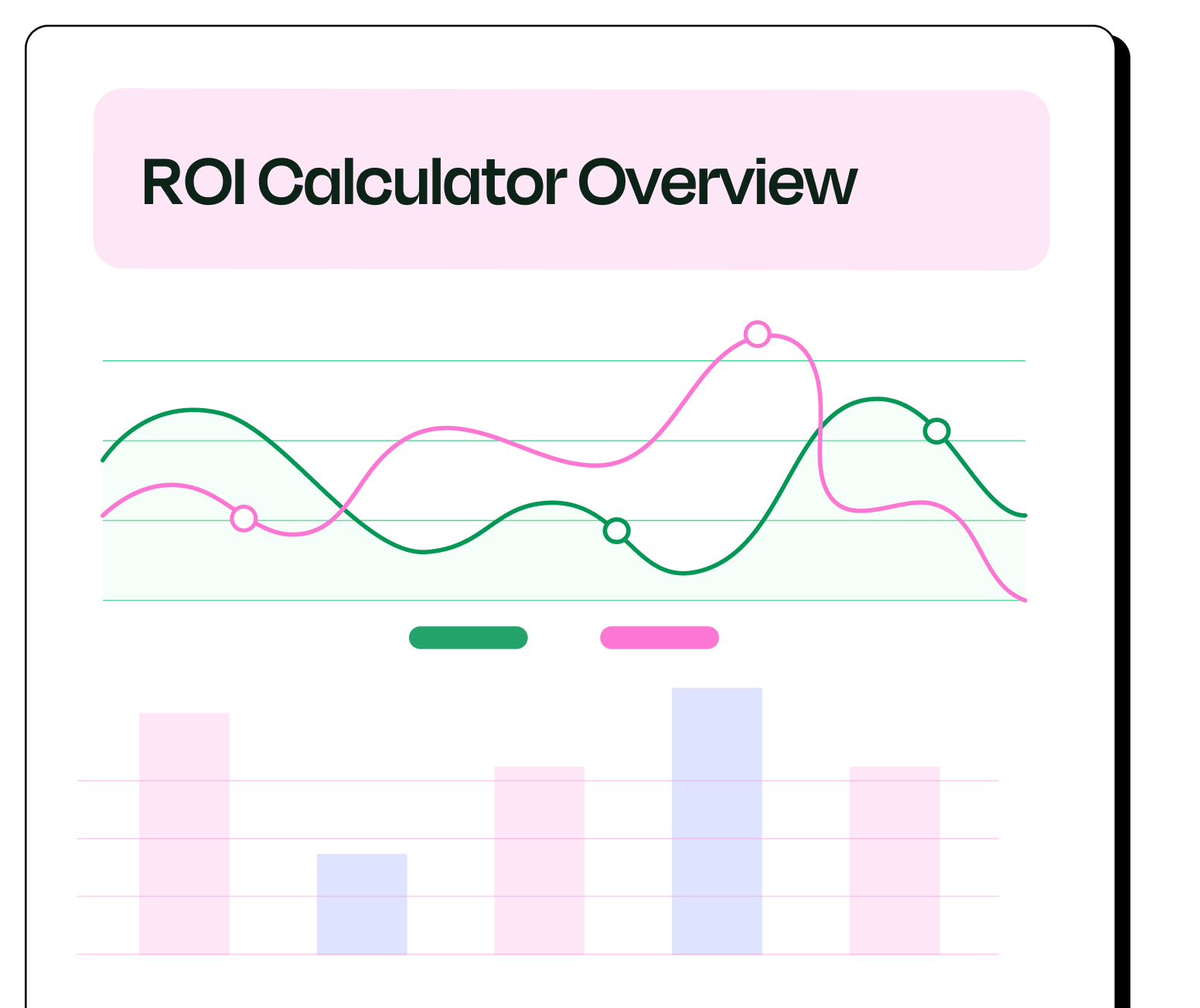

4. Cost of absenteeism
Taking the occasional personal day off or using up vacation days is no big deal. But frequent employee absenteeism is one of the telltale signs of employee disengagement.
For the same reasons, calculating the cost of absenteeism is a great way to measure the ROI on employee engagement in your company.
The cost of employee absenteeism can be calculated by taking into account both direct and indirect costs associated with employees being absent from work. The formula for calculating the cost of employee absenteeism is:
Cost of Employee Absenteeism = Direct Costs + Indirect Costs
- Direct Costs: These are the costs that are directly related to employee absenteeism, such as the cost of hiring temporary or replacement workers, overtime pay for other employees, and loss of productivity.
- Indirect Costs: These are the costs that are not directly related to employee absenteeism, but are still affected by it. Examples include costs associated with training new employees, decreased morale among remaining employees, and damage to an organization’s reputation.
Here is an example of how to calculate the cost of employee absenteeism:
Let’s say a company has an average of 100 employees and the average salary of each employee is $50,000 per year. If the company has an absenteeism rate of 10%, it means that 10 employees are absent from work every day.
Direct Costs:
- Cost of hiring temporary or replacement workers = $50,000 x 10 = $500,000
- Overtime pay for other employees = $50,000 x 10 x 10% = $50,000
- Loss of productivity = $50,000 x 10 x 10% = $50,000
Total Direct Costs = $500,000 + $50,000 + $50,000 = $600,000
Indirect Costs:
- Training new employees = $50,000 x 10 = $500,000
- Decreased morale among remaining employees = $50,000 x 10 x 10% = $50,000
- Damage to an organization’s reputation = It can be difficult to quantify, but it can be significant
Total Indirect Costs = $500,000 + $50,000
Total Cost of Employee Absenteeism = $600,000 + $550,000 = $1,150,000
It’s important to note that the cost of employee disengagement and absenteeism can vary greatly depending on the industry, the size of the company, and the specific circumstances of each case.
Further reading: Learn more about staff engagement activities you can implement, measure, and optimize at your company.
Maximize Your Employee Engagement ROI
When you encourage employees to get engaged and give feedback via internal emails and pulse surveys, you not only see your employee engagement ROI but can boost it to. Employee engagement should be considered at every point of your employees journey at your company: from their employee onboarding to their departure.
Take advantage of our email template builder features to create beautiful, responsive HTML emails or choose from our library of free templates. When you’re finished, track employee insights in your campaign dashboard. Then, deliver the data to managers and directors so they can make informed decisions that benefit your team.



